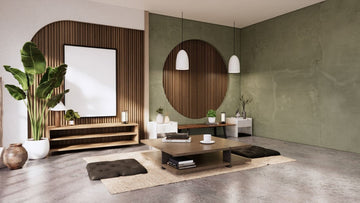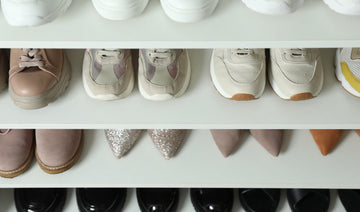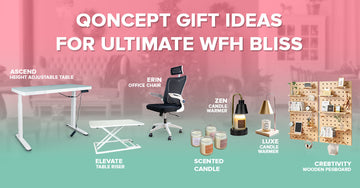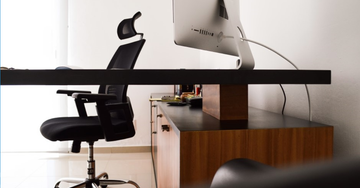Mesh vs Leather Chairs: Pros, Cons, and How to Choose the Right One
by Khent Barangas on Aug 14, 2025

If you work full-time, you're likely spending most of your day in a chair. And you’re not the only one. According to a study by Ipsos Public Affairs for Ergotron, full-time employees spend about two-thirds of their working hours sitting. With that much time spent seated, you deserve to have the best office chair material supporting you.
That brings us to two of the most popular options: mesh and leather. Both of these materials are widely used in ergonomic chairs. However, they offer very different experiences when it comes to comfort, support, and long hours at your desk.
Mesh chairs are known for being breathable and flexible. They are a favorite material for those who want to build a minimalist home office. Leather chairs, on the other hand, offer plush cushioning and a more polished, executive feel that many professionals still prefer.
So, how do you know which one is right for you?
That’s exactly what this article is here for. We’ll break down the pros and cons of both chair materials, compare their performance in real work settings, and help you determine which chair best suits your routine.
Mesh vs Leather Chair Materials: What to Know First
Ergonomic chairs can be made from various materials, but the most commonly used are mesh and leather. Both are popular choices for task chairs, executive chairs, and ergonomic seating.
Mesh chairs are typically designed with a flexible, loosely woven fabric stretched across a frame, often on the backrest and sometimes the seat. Unlike tightly woven materials, mesh fabric is constructed to leave thousands of tiny holes that allow air to flow freely.
This unique characteristic makes mesh one of the most breathable and lightweight materials available for office chairs.
Leather chairs, on the other hand, are known for their polished appearance, smooth finish, and durability. Genuine leather is made from specially treated animal hides, with cowhide accounting for about 65% of global leather production.
In contrast to mesh fabric, leather has insulating properties. This makes a leather chair feel warm and plush when seated.
Both mesh and leather remain top choices in modern workspaces, and each comes with its own advantages and disadvantages. In the following sections, we’ll take a closer look at how mesh and leather chairs compare when it comes to comfort, durability, back support, and more.
Pros and Cons of Mesh Chairs

Mesh chairs are a favorite in modern offices and work-from-home setups. They’re designed to promote airflow and support good posture, but like any chair, they come with trade-offs.
Here are the key mesh chair pros and cons to keep in mind.
The Pros of Mesh Chairs
1. Breathable and Cool
The loose weave in mesh chairs allows for excellent air circulation, which helps reduce heat buildup, especially during long work hours. If you're someone who tends to run warm or sit for extended periods, this airflow can make a noticeable difference in comfort.
2. Lightweight and Modern
Mesh chairs usually have a slim, minimal frame that’s easy to move around and doesn’t take up much space. Their modern aesthetic also fits well in smaller home offices, shared desks, or tech-forward workspaces.
Take the Kingston, for instance, one of the most favorite office chairs in Qoncept Living. Its quality mesh material, plus the curvy, sleek design, can easily complement any modern home office setup.
3. Encourages Posture
One reason mesh chairs are popular in ergonomic setups is that they work well with adjustable features. This fabric can be easily combined with adjustable features like lumbar support and tilt tension. With the right design, mesh backrests flex and adapt to the natural curve of your spine.
4. Low Maintenance
Thanks to those holes in fabric, Mesh is less likely to trap dust, dirt, or sweat. The material is easy to clean, so the mesh chair is a practical choice for everyday use.
The Cons of Mesh Chairs
1. Less Cushioning
Mesh fabric is typically used on the backrest, where its flexibility and airflow offer the most benefit. When used for the seat, mesh can sometimes feel too firm, especially if you're used to a cushioned or padded surface.
To get that softer feel, you can look for mesh chairs with foam or hybrid seating. For example, the Qoncept Living Rocio uses memory foam on the seat. This is one of the softest materials used in ergonomic chairs today. It also adapts to your body temperature and pressure for a more personalized sitting experience.
2. Varying Durability
Not all mesh is created equal. Some mesh chairs may sag or lose tension over time, especially with frequent use.
3. Aesthetic Limitation
Don’t get it wrong, mesh chairs can be visually appealing. Their casual, techy look often works well in modern or minimalist workspaces. But if you’re aiming for a more traditional or executive-style setup, they might not blend in as well. For a cohesive look, leather or upholstered chairs could be a better match.
Pros and Cons of Leather Chairs

Leather office chairs have long been associated with comfort, professionalism, and status. But just like mesh, they come with drawbacks. Below are the key leather chair pros and cons to help you decide if it’s the right fit for your workspace.
The Pros of Leather Chairs
1. Professional Appearance
If you're going for a business-like atmosphere, a leather chair is one of the best choices for your workspace. Its smooth finish and clean lines naturally add a sense of sophistication and formality.
Take the Brendad Executive Chair, for example. It combines a sleek leather design with a distinctive wood-grain finish on the back and seat frame, bringing in both elegance and visual warmth.
2. Cushioned Seating
Most leather chairs use foam padding beneath the surface. Many prefer this softer, more plush sitting experience over mesh. This type of seating often appeals to those who spend hours at a time in their chair and want something with a bit more give and comfort.
Chairs like the Qoncept Living Everest Chair feature thick, high-density foam and an adjustable recline mechanism. While it’s originally designed for gaming, you’ll definitely love its relaxed sitting experience during long work sessions or meetings.
3. Durable When Maintained Properly
Genuine leather is known to age well when taken care of. With regular conditioning and cleaning, it can resist cracking and maintain its texture over time. Even high-quality PU (polyurethane) leather can hold up to years of use while being more resistant to stains and sun exposure.
Cons of a Leather Chair
1. Can feel warm or sticky
Leather has insulating properties, which means it traps heat more than breathable materials like mesh. In warmer climates or non-airconditioned rooms, this can lead to discomfort, especially during long sitting sessions. Over time, it might feel sticky or make you sweat more easily.
2. More sensitive to scratches and wear
While leather is tough, it’s not immune to damage. Sharp objects, pet claws, or even metal buttons on jeans can leave marks. Without regular care, a leather chair may eventually show signs of wear, such as cracking or fading.
3. Usually comes at a higher price point
Genuine leather chairs are often more expensive than mesh or fabric alternatives. Even synthetic versions with added features like tilt-lock or padded armrests tend to cost more, making them less ideal for budget-conscious buyers.
4. Heavier and less portable
Because of their build and padding, leather chairs tend to be heavier and bulkier. If you need a chair that’s easy to reposition, or if you’re working in a smaller space, this could become a drawback.
Quick Comparison: Mesh vs Leather Office Chairs
Deciding between a mesh and vs leather chair? Here’s a quick overview of how these two popular office chair materials compare at a glance:
| Feature | Mesh Chair | Leather Chair |
| Breathability | Excellent airflow, ideal for warm spaces | Traps heat, less ventilation |
| Comfort | Supportive, firm feel | Cushioned, plush surface |
| Style | Modern, minimalist design | Classic, executive look |
| Maintenace | Easy to clean, resists dust | Needs regular care to avoid cracking |
| Durability | May sag over time | Long-lasting with proper upkeep |
| Price Range | Often more affordable | Usually higher in cost |
The Verdict: Which Office Chair Material is Right for You
There’s no universal winner when it comes to mesh vs leather chairs. Each one shines depending on your space, routine, and personal comfort preferences.
If you value breathability and a lightweight frame, mesh might be the better fit for your day-to-day. But if you’re after plush comfort and a more polished, professional look, leather could be the right call.
The good news is that many chairs now blend materials and ergonomic features. So, you don’t always have to choose just one.
Need help choosing? Explore our collection of ergonomic mesh and leather chairs. You can also visit our official Shopee and Lazada stores to catch the latest deals, vouchers, and exclusive offers.









